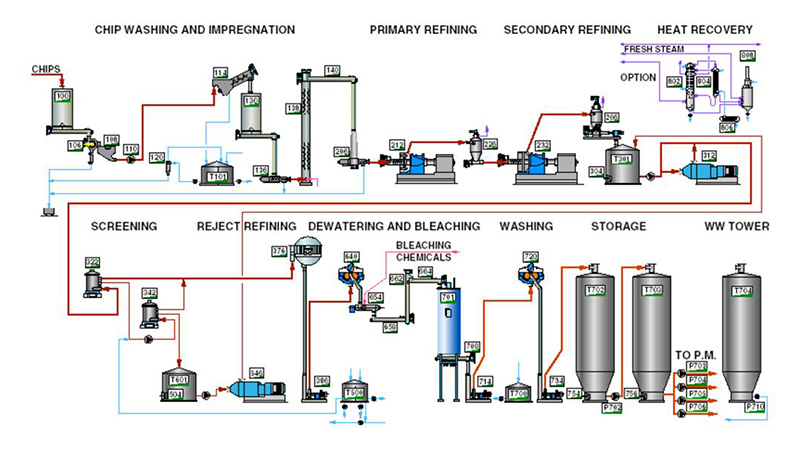Issues about semi-chemical pulping
Semi-chemical pulping is similar to chemical mechanical methods in that the material is first chemically treated and then ground into pulp. However, the degree of chemical treatment is more severe than that of chemical mechanical pulp, and 25% to 50% of lignin and 30% to 40% of hemicellulose in the raw material are removed, and the intercellular substance is partially dissolved. The semi-chemical pulping yield is between 65% and 85%.
Semi-chemical pulping (SCP) is more chemically treated than chemical mechanical pulp, but it is milder than chemical pulp. After chemical treatment, the raw material has not yet reached the fiber separation point, and it still needs to be further dissociated by mechanical means, but its coarse slag is more Soft, less power required to dissociate into fibers. It can be seen that semi-chemical pulp and chemical mechanical pulp are both chemical and mechanical two-stage pulping. The distinction between the two is often based on the yield, that is, the yield of wood raw materials is 65%-85%, called semi-chemical pulp, and the yield is over 85%. Called chemical mechanical pulp.
There are many methods for producing semi-chemical pulp. The cooking conditions are moderated on the basis of the usual chemical pulping, or the semi-chemical pulp can be obtained by strengthening the pretreatment on the basis of the chemical mechanical pulp. The earliest method is the neutral sulfite semi-chemical pulp (NSSC) pulping technology, and other methods are bisulfite semi-chemical pulp, alkaline sulfite semi-chemical pulp, ammonium imide semi-chemical pulp and green liquor. Semi-chemical pulp, etc.
In theory, all chemical cooking broths can be used to produce semi-chemical pulp. The equipment used for chemical treatment is usually steaming balls or inclined tubes.

Refining
The cooked fiber material is only partially removed from the lignin and hemicellulose, which remains essentially the same and must be mechanically treated to disperse the fibers into a slurry. The mechanical grinding of semi-chemical pulp and chemical mechanical pulp has a great influence on the properties of pulp. The degree of grinding varies with the use of the pulp. Grinding equipment is mainly a disc grinder.
NSSC pulping principle
NSSC pulping is characterized by low delignification rate at high temperature, sulfonation of lignin phenolic structural units as the main reaction, non-phenolic lignin structural units are stable, and its reaction and chemical pulping neutrality The sodium sulfite method is the same, but the reaction is lighter.
It is believed that NSSC pulping delignification can be carried out in the following steps:
- 1 The cooking liquid diffuses into the wood chip structure.
- 2 The drug is adsorbed on the surface of the lignin.
- 3 Lignin sulfonation and hydrolysis.
- 4 The reaction product is desorbed from the reaction surface.
- 5 The reaction product diffuses into the liquid phase.
The main influencing factors of NSSC pulping 1. Influence of material types For the production of NSSC pulp, the most suitable raw material is hardwood. Compared with softwood, hardwood NSSC pulp consumes less medicine at the same yield. Substances with low density are easy to soak, while those with high density are difficult to produce semi-chemical pulp. Birch and poplar are the better raw materials in hardwood, followed by beech and eucalyptus. Light-colored poplar NSSC pulp can be used to make newsprint without bleaching. Bagasse has a low lignin content, is easy to soak, and is easy to manufacture semi-chemical pulp. 2. The influence of the composition of the cooking liquid The composition of the cooking liquor varies depending on the type of sulfite, the buffer used, and their concentration. The pH of the cold liquid is between 8.0 and 9.0, and the pH value decreases as the cooking temperature increases. The type of sulfite is most used in Na2SO3, and (NH4)2SO3 is also used. The role of the buffer is to neutralize the organic acid formed in the initial stage of cooking, and control the pH of the cooking end at 7.2-7.5 to prevent hydrolysis of carbohydrates. The amount of buffer is mainly determined by the organic acid produced in the raw material, generally 1.5% to 3.0% (calculated as Na2O, dry weight of wood). The type of buffer will affect the whiteness of the slurry. When NaHCO3 is used, a higher whiteness slurry can be obtained. The ratio of Na2SO3 to NaHCO3 is preferably 4:1, and Na2CO3, NaOH or even Na2S is also used. The addition of AQ, like alkaline pulping, can speed up the rate of delignification, increase the yield of pulp, reduce chemical consumption and reduce cooking energy.
The nature and use of NSSC pulp Compared to chemical pulp, NSSC pulp retains more lignin. Compared with other semi-chemical pulps, more hemicellulose is retained. Therefore, it has high stiffness, poor folding resistance, easy beating and high transparency, and is suitable for the production of transparent paper, greaseproof paper, food packaging paper and cardboard.

